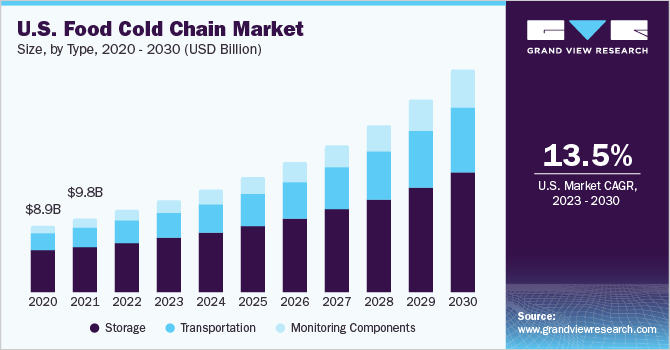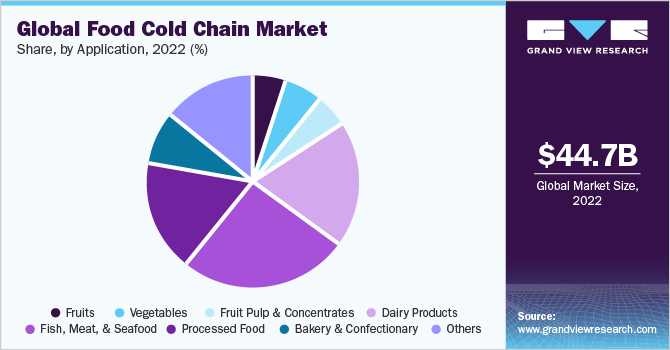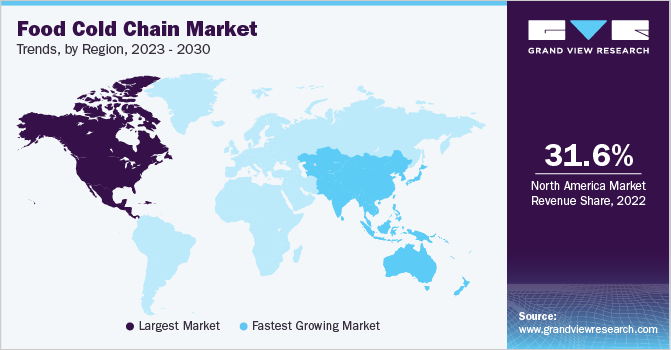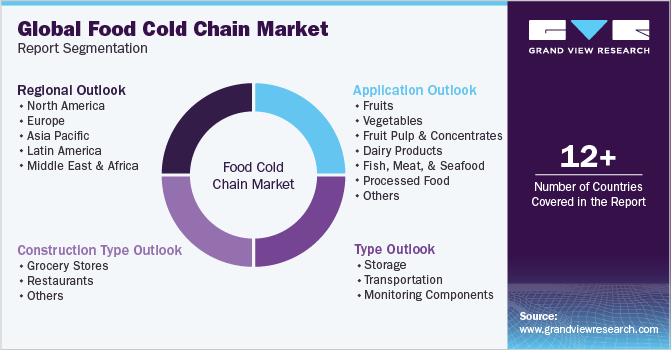- Home
- »
- Automotive & Transportation
- »
-
Food Cold Chain Market Size, Share & Growth Report, 2030GVR Report cover
![Food Cold Chain Market Size, Share & Trends Report]()
Food Cold Chain Market Size, Share & Trends Analysis Report By Type (Storage, Transportation), By Construction Type (Grocery Stores, Restaurants), By Application (Fruits, Vegetables, Dairy Products), By Region, And Segment Forecasts, 2023 - 2030
- Report ID: GVR-4-68040-106-4
- Number of Report Pages: 100
- Format: PDF, Horizon Databook
- Historical Range: 2017 - 2021
- Forecast Period: 2023 - 2030
- Industry: Technology
Report Overview
The global food cold chain market size was estimated at USD 44.71 billion in 2022 and is expected to grow at a compound annual growth rate (CAGR) of 17.3% from 2023 to 2030. The market is witnessing a remarkable surge in demand, primarily fueled by the growing consumer preference for quality foods. In recent times, there has been a substantial rise in awareness among customers regarding the criticality of food safety. As a result, there is an escalating desire for refrigerated food products that are not only fresh but also safe to consume and meet high-quality standards. This escalating consumer demand underscores the necessity for a dependable cold chain infrastructure, crucial in preserving the impeccable quality and safety of these items.

The food cold chain market includes the system that handle and transport perishable food products under controlled temperature conditions to ensure their freshness, quality, and safety from the point of production to the point of consumption. It is a crucial logistical process that involves maintaining a specific temperature range throughout the supply chain, including during transportation, storage, and distribution.
The cold chain market plays a pivotal role in this industry, especially for products like fruits, vegetables, dairy, meat, seafood, and pharmaceuticals. By using refrigerated facilities, temperature-controlled vehicles, and advanced technologies like RFID, the cold chain ensures that perishable items remain in optimal condition, reducing the risk of spoilage, bacterial growth, and other quality issues.
Moreover, RFID technology has emerged as a pivotal driver in the cold chain market, enhancing visibility and efficiency in the entire process. Maintaining optimal product temperatures during transportation and storage is a critical concern among the challenges faced in the cold chain. Any deviation from the required temperature range poses a substantial risk, leading to bacterial growth, spoilage, and deterioration of food quality.
The market is witnessing substantial growth, fueled by increased investments in its development. The rising demand for fresh and processed food products is a key driver spurred by population growth, urbanization, and evolving consumer preferences. Simultaneously, there is a heightened emphasis on tackling the critical issue of food waste on a global scale. This collective momentum is propelling businesses to channel resources into strengthening the cold chain infrastructure, ensuring efficient and seamless processes that preserve the quality and safety of food products while minimizing waste.
COVID-19 Impact
The food cold chain market in North America and Europe has been greatly impacted by the COVID-19 pandemic. This market encompasses the transportation, storage, and distribution of temperature-controlled food products. As a consequence of the pandemic, there has been a notable shift in consumer behavior towards online grocery shopping and home delivery, resulting in an increased demand for cold chain logistics services. The food supply chain, a complex network involving farmers, processors, distributors, wholesalers, and retailers, has experienced disruptions at every stage, leading to a reduced demand for temperature-controlled goods.
Among the temperature-sensitive products, fruits and vegetables have been particularly affected, necessitating careful handling and transportation to maintain their freshness and safety. The closure of restaurants and reduced international trade due to travel restrictions has significantly diminished the demand for these perishable items. Consequently, many farmers have faced challenges in selling their produce, incurring substantial losses within the agriculture industry. Moreover, the decreased demand for temperature-controlled products has contributed to a rise in food wastage, leading to additional economic and environmental concerns.
Type Insights
The storage segment led the market and accounted for more than 57% share of the global revenue in 2022. By type segment, the market is bifurcated into storage, transportation, and monitoring components. In the market, the storage component plays a crucial role by providing specialized facilities and solutions to maintain food products at optimal low temperatures throughout their journey from production to consumption. The storage segment is further bifurcated into reefer containers and warehouses. Factors driving the increasing demand for perishable food include shifting consumer preferences, population growth, and urbanization. Moreover, technological advancements have played a significant role in enhancing the efficiency and reliability of cold storage solutions, further bolstering their importance in the industry.
These temperature-controlled storage systems are paramount in preserving perishable goods' quality, safety, and freshness, such as fruits, vegetables, dairy products, meat, and seafood. The storage segment encompasses various cold storage facilities, including refrigerated warehouses, walk-in coolers, freezers, and refrigerated containers for transportation. These storage solutions ensure that temperature-sensitive items are kept within the required temperature range to prevent spoilage, bacterial growth, and quality degradation.
The monitoring components segment is anticipated to witness the fastest CAGR of 19.7% throughout the forecast period. Monitoring components are vital in temperature-controlled food logistics to ensure that perishable goods maintain the required temperature range throughout transportation, storage, and distribution processes. The market for monitoring components in temperature-controlled food logistics is driven by several key factors. The growing focus on food safety and quality regulations by governments and regulatory bodies worldwide has prompted businesses to adopt advanced monitoring technologies.
Compliance with these stringent requirements ensures the integrity of their products throughout the supply chain. These essential components include advanced temperature sensors, data loggers, real-time tracking systems, and sophisticated software solutions. Working in sync, they offer accurate and real-time information about the storage and transportation conditions of temperature-sensitive products. By continuously monitoring temperature fluctuations and potential deviations, these components play a crucial role in preserving the quality, safety, and freshness of perishable items.
Construction Type Insights
The restaurants segment led the market and accounted for more than 47% share of the global revenue in 2022. By construction type segment, the market is bifurcated into grocery stores, restaurants, and others. The construction segment is focused on creating facilities designed to store and transport fresh produce at low temperatures. These facilities are essential for maintaining the quality and freshness of perishables by effectively controlling and continuously monitoring temperature, humidity, and other environmental conditions. By using advanced designs and materials, these specialized constructions ensure that temperature-sensitive food items are preserved in optimal conditions throughout their journey from production to consumption.
Restaurants play a significant role in the temperature-controlled food supply chain. They are key players in the market as they rely on the cold chain to ensure the freshness and safety of their perishable food ingredients. Restaurants depend on temperature-controlled storage and transportation solutions to maintain the quality of their ingredients, such as fruits, vegetables, dairy products, meat, and seafood, from the supplier to their kitchen. Several factors primarily drive the demand for temperature-controlled food logistics in the restaurant sector. The emphasis on food safety and quality by consumers and regulatory bodies has compelled restaurants to ensure the integrity of their ingredients throughout the cold chain process. By adhering to stringent food safety standards, restaurants can build trust with their customers and safeguard their reputation.
The grocery stores segment is anticipated to grow at a considerable CAGR of 18.7% throughout the forecast period. Temperature-controlled storage and transportation systems are indispensable to uphold the quality and safety of perishable goods. As a result, grocery stores that offer perishable food items are purposefully designed with specific features to ensure precise temperature and optimal conditions throughout the supply chain. This meticulous process begins with storage at the distribution center, extends to transportation, and ultimately culminates at the store for the benefit of the end consumer.
Some typical design aspects found in food cold chains for grocery stores encompass insulated walls, floors, and ceilings, all of which contribute to maintaining a controlled environment. Refrigeration units and freezers are pivotal in cooling to preserve perishable goods. To ensure precise regulation, temperature sensors and monitoring systems are thoughtfully integrated into the store's infrastructure.
Application Insights
The fish, meat, and seafood segment led the market and accounted for more than 25% share of the global revenue in 2022. By application segment, the market is bifurcated into fruits, vegetables, fruit pulp & concentrates, dairy products, fish, meat, and seafood, processed food, bakery & confectionary, and others. The growth of the market is primarily driven by the growing global demand for fresh, high-quality, and safe protein sources significantly influences the need for efficient cold chain logistics.
Consumers have heightened expectations regarding the quality and safety of these products, prompting businesses to prioritize temperature-controlled solutions to meet these demands. Additionally, the expansion of international trade and the rise of e-commerce has further propelled the segment, necessitating robust cold chain systems to facilitate smooth and reliable distribution to various markets. Overall, implementing effective food cold chain practices plays a pivotal role in meeting customer expectations and supporting the growth of the fish, meat, and seafood market.

The processed food segment is anticipated to grow at a considerable CAGR of 19.1% throughout the forecast period. The changing consumer lifestyle and preferences have increased demand for convenient and ready-to-eat food options. Processed food caters to these needs, offering a wide range of convenient and easy-to-prepare meals. Secondly, urbanization and busy schedules have resulted in a growing reliance on processed food products, as they provide a quick and accessible solution for consumers with limited time for cooking.
Additionally, the expansion of the global population and the rise of disposable income have further fueled the demand for processed food, especially in emerging economies. Moreover, advancements in food processing technology and packaging techniques have contributed to the growth of the processed food market. These innovations have improved the quality and variety of processed food products, attracting more consumers to choose these convenient options.
Regional Insights
North America led the overall market in 2022, with a revenue share of 31.6%. In North America, the food cold chain is a comprehensive and efficient system that ensures the timely and safe delivery of fresh produce from farm to customer. This well-organized cold chain encompasses cold storage facilities, refrigerated vehicles, and distribution centers, all working together to maintain ideal temperature and humidity levels for the perishable goods.

A prime example of North America's food cold chain is the supply chain for lettuce. After harvesting, the lettuce is promptly taken to refrigerated storage, which undergoes cleaning and drying. Next, the lettuce is carefully loaded into cold-climate trucks, which transport it to a distribution facility. At this center, the lettuce is sorted, packaged, and kept in a chilled warehouse until it's time for distribution to supermarkets, eateries, or other service providers.
Another illustration in North America is observed in the supply chain for fresh berries. Due to their high perishability, berries require delicate handling to preserve their freshness and flavor. Once harvested, the berries are swiftly taken to a cold storage facility for sorting and packaging. They are then transported in chilled trucks to a distribution center, where they remain chilled until they are ready for shipping. At every stage of the cold chain, temperature and humidity levels are meticulously monitored to ensure that the berries maintain their freshness and top-notch quality.
Asia Pacific is expected to grow notably with a CAGR of 24.1% over the forecast period. The Asia Pacific food cold chain sector is a significant contributor to the continent's economy, supporting local and regional agriculture and providing employment opportunities for thousands. However, it faces several challenges, including increasing demand for fresh produce, complex supply systems, and evolving consumer preferences. In response to these challenges, cold chain providers in the region are actively investing in cutting-edge innovations and new technologies to strengthen the cold chain and effectively address these issues.
Apart from enhancing the quality and safety of fresh products, the food cold chain plays a critical role in promoting sustainability and reducing the environmental impact of the food industry. By minimizing wastage and improving efficiency, the cold chain helps to reduce the carbon footprint caused by the transportation and distribution of fresh food. It also supports sustainability efforts by assisting local and regional agriculture.
Key Companies & Market Share Insights
The food cold chain market is highly competitive. Major players are investing in Research & Development (R&D) to drive innovation. The key players are adopting different development strategies such as product launches, mergers & acquisitions, and others to expand their presence and market share in the food cold chain market. Along with key strategies these players are introducing new features to improve the customer experience.
In January 2023, the Ministry of Agriculture and Farmers Welfare announced the launch of the India Cold Chain Programme in collaboration with the National Centre for Cold Chain Development (NCCD) and the UN Environment Programme under the framework of the Cool Coalition. The program is strategically developed in partnership with the Alliance for an Energy-Efficient Economy (AEEE), Energy Efficiency Services Limited (EESL), and the Bureau of Energy Efficiency (BEE). Its primary objective is to drive policymaking and promote the adoption of energy-efficient and environmentally friendly cold chain practices throughout the country. Some prominent players in the global food cold chain market include:
-
Americold Logistics LLC
-
Agro Merchant Group
-
Burris Logistics, Inc.
-
Henningsen Cold Storage Company
-
Lineage Logistics, LLC
-
Nordic Logistics
-
Preferred Freezer
-
Wabash National
-
Cold Chain Technologies, Inc.
-
Cryopak Industries Inc.
-
Creopack
-
Cold Box Express, Inc.
-
Intelsius
-
Nilkamal Limited
-
Sofrigam
-
Softbox Systems Ltd.
-
Sonoco ThermoSafe
-
Valor Industries
-
va Q tec AG
Food Cold Chain Market Report Scope
Report Attribute
Details
Market size value in 2023
USD 51.40 billion
Revenue forecast in 2030
USD 156.77 billion
Growth rate
CAGR of 17.3% from 2023 to 2030
Historic year
2017 - 2021
Base year for estimation
2022
Forecast period
2023 - 2030
Quantitative units
Revenue in USD million/billion and CAGR from 2023 to 2030
Report coverage
Revenue forecast, company ranking, competitive landscape, growth factors, and trends
Segments covered
Type, construction type, application, region
Regional scope
North America; Europe; Asia Pacific; Latin America; Middle East & Africa
Country scope
U.S.; Canada; UK; Germany; France; India; China; Japan; South Korea; Australia; Brazil; Mexico; Kingdom of Saudi Arabia (KSA); UAE; South Africa
Key companies profiled
Americold Logistics LLC; Agro Merchant Group; Burris Logistics, Inc.; Henningsen Cold Storage Company; Lineage Logistics, LLC; Nordic Logistics; Preferred Freezer; Wabash National; Cold Chain Technologies, Inc.; Cryopak Industries Inc.; Creopack; Cold Box Express, Inc.; Intelsius; Nilkamal Limited; Sofrigam; Softbox Systems Ltd.; Sonoco ThermoSafe; Valor Industries; va Q tec AG
Customization scope
Free report customization (equivalent up to 8 analysts working days) with purchase. Addition or alteration to country, regional & segment scope.
Pricing and purchase options
Avail customized purchase options to meet your exact research needs. Explore purchase options
Global Food Cold Chain Market Report Segmentation
This report forecasts revenue growth at global, regional, and country levels and offers qualitative and quantitative analysis of the industry trends for each of the segment and sub-segments from 2017 to 2030. For this study, Grand View Research has segmented the global food cold chain market report based on type, construction type, application, and region:

-
Type Outlook (Revenue, USD Million, 2017 - 2030)
-
Storage
-
Warehouses
-
Reefer Containers
-
-
Transportation
-
Road
-
Sea
-
Rail
-
Air
-
-
Monitoring Components
-
Hardware
-
Sensors
-
RFID Devices
-
Telematics
-
Networking Devices
-
-
Software
-
On-premise
-
Cloud-based
-
-
-
-
Construction Type Outlook (Revenue, USD Million, 2017 - 2030)
-
Grocery Stores
-
Restaurants
-
Others
-
-
Application Outlook (Revenue, USD Million, 2017 - 2030)
-
Fruits
-
Apples
-
Banana
-
Berries
-
Nectarines, Plums, and Peaches
-
Melons
-
Others
-
-
Vegetables
-
Leafy Vegetables
-
Lettuce
-
Onions
-
Potato
-
Others
-
-
Fruit Pulp & Concentrates
-
Dairy Products
-
Fish, Meat, and Seafood
-
Processed Food
-
Bakery & Confectionary
-
Others
-
-
Regional Outlook (Revenue, USD Million, 2017 - 2030)
-
North America
-
U.S.
-
Canada
-
-
Europe
-
UK
-
Germany
-
France
-
-
Asia Pacific
-
India
-
China
-
Japan
-
South Korea
-
Australia
-
-
Latin America
-
Brazil
-
Mexico
-
-
Middle East & Africa
-
Kingdom of Saudi Arabia (KSA)
-
UAE
-
South Africa
-
-
Frequently Asked Questions About This Report
b. The global food cold chain market size was estimated at USD 44.71 billion in 2022 and is expected to reach USD 51.40 billion in 2023.
b. The global food cold chain market is expected to grow at a compound annual growth rate of 17.3% from 2023 to 2030 to reach USD 156.77 billion by 2030.
b. North America led the overall market in 2022, with a market share of 31.6%. In North America, the food cold chain is a comprehensive and efficient system that ensures the timely and safe delivery of fresh produce from farm to customer. This well-organized cold chain encompasses cold storage facilities, refrigerated vehicles, and distribution centers, all working together to maintain ideal temperature and humidity levels for the perishable goods.
b. Americold Logistics LLC, Agro Merchant Group, Burris Logistics, Inc., Henningsen Cold Storage Company, Lineage Logistics, LLC, Nordic Logistics, Preferred Freezer, Wabash National, Cold Chain Technologies, Inc., Cryopak Industries Inc., Creopack, Cold Box Express, Inc., Intelsius, Nilkamal Limited, Sofrigam, Softbox Systems Ltd., Sonoco ThermoSafe, Valor Industries, va Q tec AG
b. The market is witnessing a remarkable surge in demand, primarily fueled by the growing consumer preference for quality foods. In recent times, there has been a substantial rise in awareness among customers regarding the criticality of food safety.
Share this report with your colleague or friend.
![gvr icn]()
NEED A CUSTOM REPORT?
We can customize every report - free of charge - including purchasing stand-alone sections or country-level reports, as well as offer affordable discounts for start-ups & universities. Contact us now
![Certified Icon]()
We are GDPR and CCPA compliant! Your transaction & personal information is safe and secure. For more details, please read our privacy policy.
We are committed towards customer satisfaction, and quality service.
"The quality of research they have done for us has been excellent."





